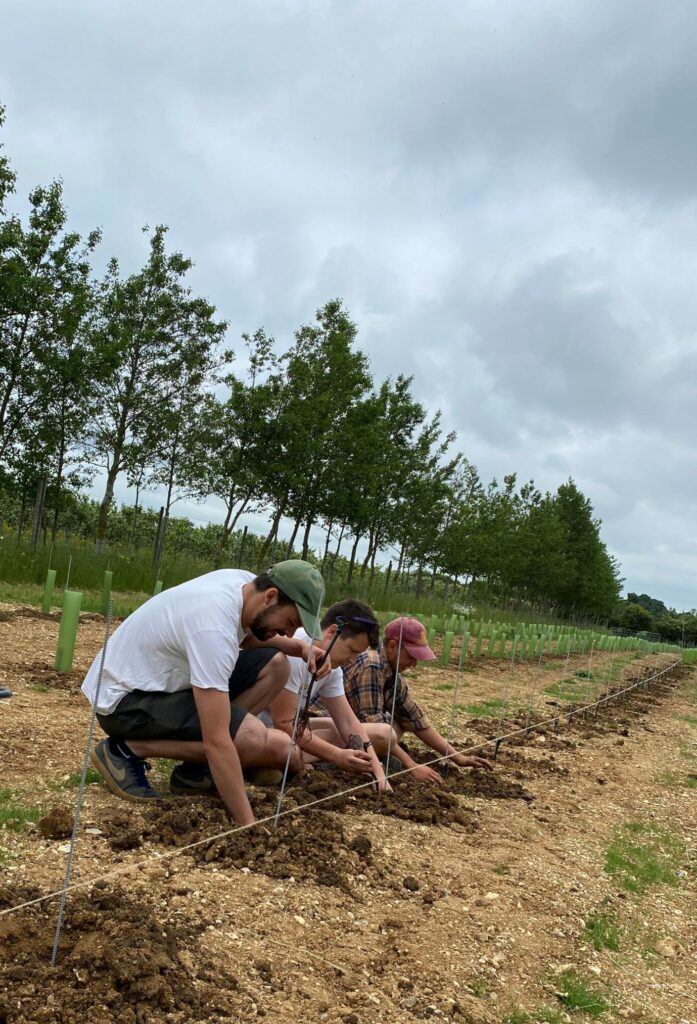As you can probably imagine, maintaining and nurturing our vines occupies most of our waking thoughts. As a growing vineyard, we also spend a lot of time and energy planning for new vines, so we keep increasing both the varieties and volumes of wine that we can produce.
This month, we have been busy hand planting an additional 500 vines. These vines have been planted at the lowest section of our vineyard, just next to our new winery (launching later this year).

New show vines
The choice of location serves a dual purpose. The gentle slopes on which the vines are planted are perfectly suited to growing fine grapes, and the resulting yield will be used in our wines. However, we also decided to plant here so the vines can become a key feature of our educational Tours & Tastings experience.
Located at the new epicentre of the vineyard, they will allow our guests to get up close when they visit, to learn more about how our grapes are grown and the different ways in which they are pruned.
Pinot Gris and Pinot Noir
The new vines are made up of 300 Pinot Gris and 200 Pinot Noir grape varieties. Pinot Gris produces a light and fresh style of wine , which eventually will become one of two varieties in a Blanc De Blancs wine we have planned for the future. We first planted Pinot Gris at Saffron Grange in 2018 and we expect to get our first crop at this year’s harvest.
The Pinot Noir grapes will go into our signature Classic Cuvée and popular Pinot Noir Rosé. The Pinot Noir grape is one of the three red ‘noble’ varieties of grape, traditionally associated with only the highest quality wines. Noble grapes – unlike the more widespread hybrid varieties – are said to retain their character wherever they are planted. The success of our first 100% Pinot Noir Rosé last year is testament to the delicious and complex character of this wine.
Perfect planting conditions
This Spring we had the perfect conditions for planting vines – very cold weather, followed by beautifully sunny days and then a good amount of rain. Vines actually prefer little water – in fact, the roots respond well to the effort of working hard to it. It helps the root system develop and strengthen, whilst also building in resilience for future dry spells.
This year it took our team of three about a week to plan, mark and plant the new vines. We prepare the soil and then plant a small whip – approximately 30cm long. Like many fruit plants available to buy today, vines are made up of a root stock with a clone on top which gives you your grape variety of choice. We use a rootstock that is suited to the conditions in the Saffron region, tolerant to chalk and the calcium carbonate in the soil.
Once the vines are in the ground, the almost immediate task is to keep the weeds down – particularly those close to the bottom of the vines, to ensure there is as little competition for the new shoots as possible. We then focus on ensuring there are enough nutrients and nourishment in the ground to help them grow.
Producing for decades to come
We’ll allow the vines to grow tall during the first year, but then we cut them right back down again at winter pruning to just two buds at the base of the vine. If the vine grows too much in the first couple of years, it will stress the root system too much. After this second phase of growth, we allow the vines to start to develop their canopy, and they will start to look more like the more developed vines in other parts of the vineyard.
This is where you will start to see the trunk develop that will sustain the vine for many years to come. Vines are in peak production for about 30 years, so it is always a satisfying sight to see so many newly planted vines, knowing that they will sustain the production of our delicious wines – as well as our local wildlife ecosystem – for many decades to come.